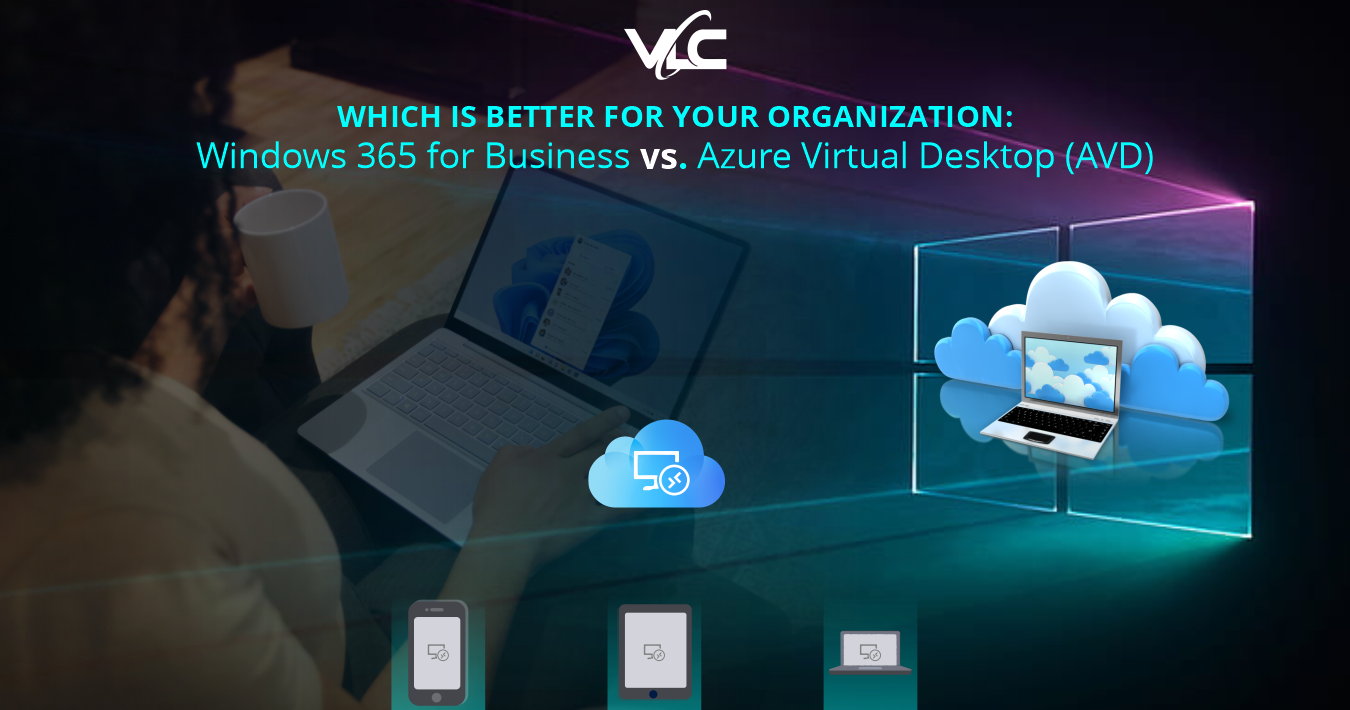Which Is Better for Your Organization: Windows 365 for Business vs. Azure Virtual Desktop (AVD)
On one side, the virtual desktop provided by Azure Virtual Desktop (AVD) and other comparable services are close to those provided by Windows 365 Cloud PCs, on the other hand, it is a managed personal Windows device that functions like a real device. In this blog entry, we have tried to contrast Windows 365 with the widely used Azure Virtual Desktop service and examine the different use cases where Windows 365 is the best option and others where AVD should be used.
Scenarios where Windows 365 is More Appropriate:
When Users Must Access Their Desktops Constantly
Auto-scaling is a popular method of reducing Azure costs when utilizing Azure Virtual Desktop. In contrast, cloud PCs are always running, so turning them off doesn’t result in any cost savings. Windows 365 is much more cost-optimized and simpler to set up and manage if users require access to their Cloud PC continuously.
Ten or Less Desktops
Windows 365 Business is the best option if the IT atmosphere only has a few desktop computers. In contrast to AVD, it does not call for any preconditions. In such cases, Windows 365 Business is an evident choice in terms of strategic planning, roll out and cost-effectiveness.
When There is Existing Capital for Microsoft Endpoint Manager
Windows 365 is a simple option for businesses that have already invested in Microsoft Endpoint Manager to handle physical desktops and laptops to expand their present system with cloud PCs. Both physical and cloud-based PCs can be managed using comparable policies.
No Present or Future Azure Footprint
Some businesses have basic, cloud-only IT atmospheres that only include SaaS products like Microsoft 365 (Office 365) and have no thoughts of adding any architecture to Azure. Windows 365 Business is a great option in this situation because it makes it simple to allocate desktops to users and has minimal administrative requirements from IT administrators.
Lack of Strong Background in Desktop Virtualization (Emerging Technology)
Nowadays, only a small percentage of Windows systems are virtualized using tools like AVD. Desktop virtualization is a sophisticated technology that calls for specialized knowledge. One such technical expertise is lacking in many organizations, and they are not seeking to develop it.
Windows 365 Enterprise is a fantastic choice in this situation. Understanding multi-session management, profile encapsulation, auto-scaling, and other intricate AVD ideas are optional. Rather, it offers a more straightforward method for managing and deploying Cloud PCs besides the current physical PCs in a similar manner.
Individual Desktops and Local Admin Privileges
Cloud PCs are intended to be specialized, private VMs that belong to each unique user. These users might mandate the power to control their own PCs, perhaps by installing software or changing other configurations that call for local administrator privileges. With Windows 365 Cloud PCs, IT can give users control over managing Cloud PCs.
Scenarios where Azure Virtual Desktop might be More Suitable
When the Most Significant Factor is the Cost Involved
Supposing cost as the main factor and aggregated Azure Virtual Desktops are available to centralize multiple users on a shared VM. In that case, AVD is the superior option because, in this case, it will be far more cost-sensitive than Windows 365. Aggregated AVD desktops typically cost up to 58% less than dedicated Cloud PCs
Extreme Monthly Swings in the Number of Desktops Required
Monthly subscriptions are used for Windows 365 licenses. Having been purchased, they are immediately usable, and the expense is incurred whether or not users utilize their desktops. AVD might be a better fit in IT settings where the number of virtual desktop users varies from month to month. Unlike Windows 365, which incurs costs pretty shortly after a per-user license is purchased, Azure Virtual Desktop capital costs are only racked up when users are genuinely using the resources.
RemoteApp Streaming Software
Occasionally only a published application is required, not a full Windows desktop session. Within those situations, a published RemoteApp application is preferable to employing a full Cloud PC (or AVD desktop), which would be way over the top. Because Windows 365 Cloud PCs cannot publish RemoteApps, Azure Virtual Desktop is the recommended option.
Last but not least, irrespective of actual use, Windows 365 costs are influenced by the number of consumers with designated Cloud PCs. The quantity of simultaneous users, which is frequently much smaller than the total number of customers delegated to desktops, determines the cost of the Azure Virtual Desktop architecture.
In conclusion, we can see that Windows 365 Cloud PCs are most affordable for lite users (non-AutoCAD and Inventor) who require devoted, enduring desktops and who will use them for more than 55 hours a week. Utilizing pooled desktops and auto-scaling technology produces significant infrastructure efficiency gains for users who do not require committed continual desktops. Talk to one of our technical specialists today to gain better insights into choosing the right option for your enterprise.
